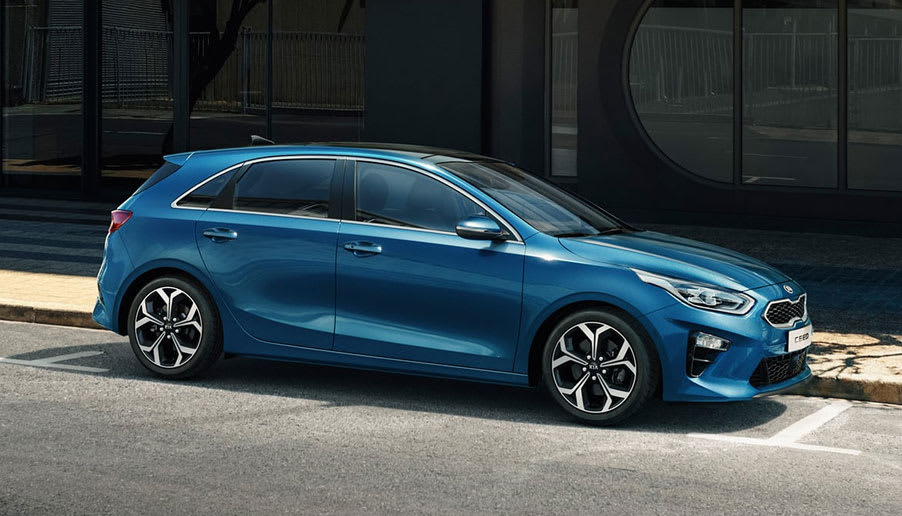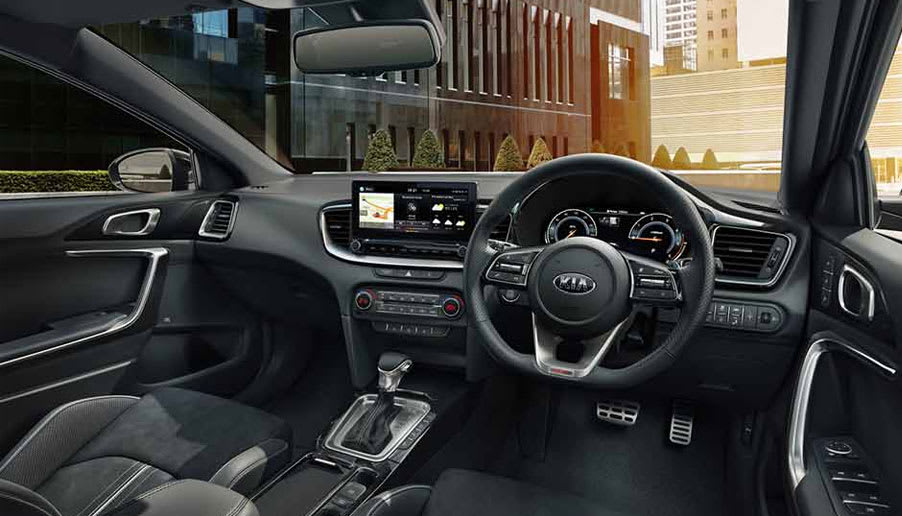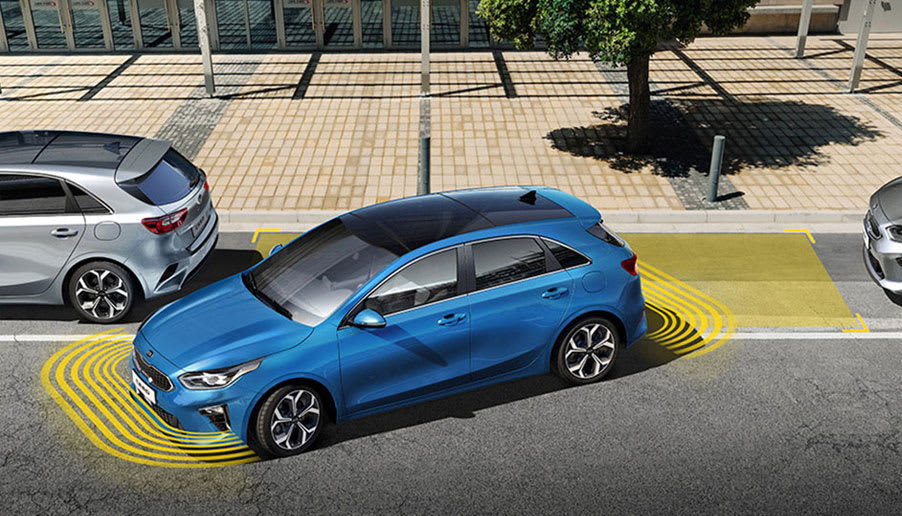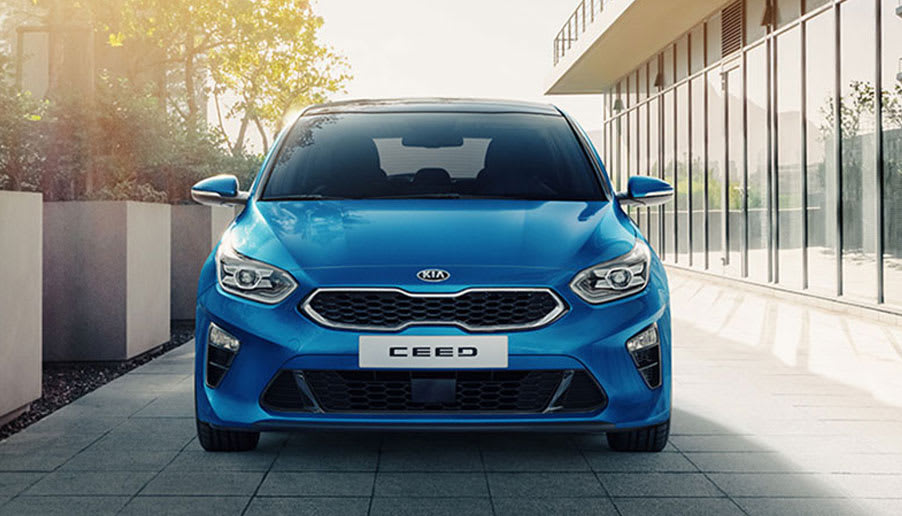
Kia Ceed Review

Introduction
Kia has come an awfully long way in the past decade or so. Like Skoda and Hyundai, the South Korean brand was once the butt of jokes and subjected to derision from many, but times have changed. Today, Kia builds some brilliant cars that are as reliable and as well-engineered as their European rivals. Long warranties and competitive pricing only add to the allure.
One car epitomises this more than any other. The Ceed is Kia’s answer to the Volkswagen Golf, so it’s a family hatchback designed to take two adults, two children and their luggage around the country in comfort. It’s a simple brief, and the Kia fulfills it brilliantly. It has just the right amount of space, just the right amount of technology and just the right trade-off between handling and comfort. In fact, it’s just like the Golf.
Select's rating score* - 3.7 / 5
At a Glance
The conventional family hatchback shape has become very familiar over the years, and familiarity, as we know, breeds contempt. Which means we aren’t often enamoured with the way cars such as this look. The VW Golf, Ford Focus and Vauxhall Astra are all mired in this mush of similarity. Sure, the next-generation Astra and 308 both look good, but they’re still just variations on the same theme.

All of which means most people won’t look twice at the Ceed, and that’s a shame. The front end looks quite sporty when you think about it, and the chiselled surfaces create an air of understated handsomeness. And it’s the same story inside, where the Ceed feels more solid than you might think and the technology is much better than it looks. This is a car that doesn’t shout about its talents.
Of which, we might add, there are many. The Ceed doesn’t set the world alight in any particular regard, but it’s very good in every respect. Take, for example, the handling. The Ceed grips well and turns in nicely – particularly in go-faster GT form – but the steering is a little too light and numb to put it in the same class as the Ford Focus and Mazda3. Similarly, the boot is slightly larger than that of the Golf or the Focus, so there’s plenty of space on board, but the Skoda Scala and Honda Civic just offer that little bit more. This is one of those dependable cars that does everything well, but isn’t quite class-leading in any one particular area.
Key Features
The Ceed doesn’t sparkle in any one area, but puts on a solid showing across the board. That makes it tough to pick out its best features. That said, it does come with a strikingly well built interior that will surprise people unfamiliar with Kia’s rise from the budget mire. The quality on show is easily on a par with European rivals, and in places, the Kia is even better.

The infotainment system also deserves a shoutout, because it’s managed to avoid falling into the trap of over-complication. It doesn’t look as pretty as some cars’ set-ups, but it’s easy to read, the menus are usually logical and the virtual buttons are mostly easy to press – even when you’re on the move. It’s a lesson in how to do infotainment properly.
Performance & Drive
The Ceed doesn’t try to match the Golf for refinement or the Focus for handling, so you get this amicable balance of the two. The ride isn’t quite as smooth as that of the Vauxhall Astra, but nor is it as brittle as that of the VW Golf R. And while it doesn’t turn into corners as eagerly as a Mazda3, it doesn’t feel as soft as the Citroen C4.

This kind of compromise sums up the Ceed, but don’t mistake that for an insult. The ride is perfectly pleasant on almost all types of road, even with the 17-inch alloy wheels. The go-faster GT model does feel slightly less pliant over poor road surfaces, but for the rest of the range, only a few harsh potholes will disturb the peace.
And on more open, more demanding country roads, the Ceed holds up well. The steering feels a bit lifeless, which spoils the experience somewhat, but the wheels respond swiftly to your inputs and there’s plenty of grip. Only when you really throw it around will it start to complain, but you’re never going to do that on a public road.
The Ceed’s amiable nature is helped by the selection of engines available. The range kicks off with a 1.0-litre turbocharged petrol engine with 120hp, and that’ll get you from 0-60mph in just under 11 seconds. If you want a bit more power, you can have the 1.5-litre petrol engine with 160hp, or you can have the 136hp 1.6-litre diesel.
Going for the diesel will only give you a slight performance boost, but the 1.5-litre petrol is quite perky. It’ll get from 0-60mph in eight-and-a-bit seconds. But for performance, the 1.6-litre, 204hp petrol engine from the GT model is the one to have. That isn’t quite fast enough to match the Golf GTIs and Focus STs of this world, but it still feels meaty and willing, and it’ll do 0-60mph in about seven seconds. It’s brisk, without being rapid.
Running Costs & Emissions
If you want to keep running costs down, the 1.6-litre diesel engine appears to be the obvious candidate. The 136hp engine will manage more than 60mpg on the official fuel economy test, and none of the petrol engines will come close to that. They’ll manage about 50mpg at best – and that isn’t bad – but it isn’t quite as impressive as the diesel. If you do regular long trips, the diesel is probably the one to go for, but if most of your time is spent in town, stick with the petrols.
When it comes to company car tax, the lines are a little more blurred. With the manual gearbox, the diesel will emit 120g of carbon dioxide per kilometre travelled, putting it in the 28% company car tax bracket. However, in entry-level models, the 1.0-litre petrol engine emits slightly less CO2, at 119g/km. That’s enough to put it in the 27% bracket.
So it’s petrol all the way, then? Well no, because more luxurious trim levels increase the petrol engine’s CO2 emissions to 126g/km, bumping it up into the 29% bracket. The diesel’s emissions are the same no matter which trim you choose. And just to throw another spanner in the works, you have to factor in the petrol car’s lower list price, which changes how much you’ll actually pay.
The truth is choosing between the two engines will be a toss-up and depends on a million different things. But it’s worth remembering there’s no plug-in hybrid version of the Ceed at present, whereas you can get more tax- and fuel-efficient versions of several rival cars.
Interior & Technology
If you come to the Ceed expecting a bargain-basement interior, you’re in for a shock. The Kia’s cabin is beautifully built, with lovely soft plastic on the dashboard and plenty of on-board technology. The fit and finish is as good as you’ll find in any mainstream European manufacturer’s cars, and better than most. It really is up with the Fords, Volkswagens and Seats of this world.

Admittedly, some of the switchgear feels a tad cheap, the design is a bit uninspiring and there are some oddly positioned buttons, but that’s nit-picking in what is, when all is said and done, a competitively priced family hatchback. You shouldn’t really expect Audi levels of class. But that said, the Kia gets far closer than you might imagine, and it should be applauded for that.
Kia has also surpassed many of its more established rivals when it comes to on-board technology. The Ceed’s cabin is not a hotbed of technological wizardry, but that’s fine. It just means you don’t need a degree in computing to operate any of the parts. The climate control, for example, is controlled using dials on the dashboard – none of this touchscreen nonsense. It’s a much better way of doing things.
But where the Ceed does make use of its touchscreen, it should be lauded. The system doesn’t look as polished as that of a VW or a Skoda, but it’s easy to navigate and use, and it clearly displays the information you need. And you can’t even accuse it of being low on functionality. The Apple CarPlay and Android Auto smartphone integration systems are standard and the larger 10.25-inch touchscreen in high-end models comes with a clever telematics system that allows you to lock the doors or check the fuel level using your phone.
Practicality & Boot Space
The Ceed is a practical car, with plenty of space for four adults and their luggage. The back seats offer decent head- and leg-room, but they aren’t quite class-leading in terms of outright space. Two six-footers will fit in there no problem, although cars with the panoramic sunroof will lose some headroom. In the front, meanwhile, the car feels light and airy, with bags of room for even very tall drivers. And the driving position is good, too.
At the other end, the 395-litre boot compares favourably with the class-leading Volkswagen Golf and Ford Focus. It offers more space than you’ll find in either of those cars, and if you fold the back seats down you get an almost flat floor. However, it isn’t the most spacious car in the class, with the Honda Civic and Peugeot 308 both offering more outright capacity.
Safety
The Ceed’s Euro NCAP crash test result is slightly confusing. That’s because it has two scores – a four-star rating and a five-star rating. Both are solid scores, but the five-star rating was achieved with the Advanced Driving Assistance Pack, which includes more sophisticated emergency braking systems and suchlike.

For the most important aspects of the Euro NCAP test, the Ceed scored solidly regardless of whether the safety pack was fitted. Strong scores for adult and child occupant protection were achieved for both vehicles tested, and the differences between the safety assistance and pedestrian protection scores were marginal. With all UK cars getting automatic braking technology that can brake for unseen pedestrians, the scores would doubtless be even closer.
In short, don’t be put off by the discrepancy in the scores. The Ceed is unquestionably a safe car in any guise, with lane-keeping assistance included as standard. If you want blind-spot monitoring and a few other additions, go for the high-end GT-Line S model.
Options
The Ceed comes with a fairly straightforward range of trim levels, although there are quite a few of them. With six to choose from, you have plenty of choice, and that’s before you consider engine-and-gearbox combinations or colour schemes.
Strangely enough, the range kicks off with the ‘2’ trim. Before you ask, we don’t know what happened to ‘1’ either. Anyway, this entry-level grade comes with 16-inch alloy wheels, air conditioning and a touchscreen infotainment system with the Android Auto and Apple CarPlay smartphone integration tech. You also get a reversing camera and cruise control.

Stepping up a level takes you to the ‘2 Nav’ model, and there are no prizes for guessing the key difference between that and its understudy. Instead of the standard touchscreen, the 2 Nav gets a larger 10.25-inch screen with satellite navigation and telematics, which gives you access to vehicle functions remotely using a smartphone.
Opting for the mid-range ‘3’ version gets you 17-inch alloy wheels, two-zone climate control and rear parking sensors, plus automatic windscreen wipers and tinted rear windows. You also get an auto-dimming rear-view mirror, which comes in handy when you’re being followed by a car with particularly bright headlights.
Stepping up again will take you to the GT-Line model, which also provides 17-inch alloy wheels but boasts a much sportier demeanour. You get more aggressive bumpers and a motorsport-inspired cabin with a D-shaped steering wheel. But you also benefit from heated front seats, a heated steering wheel and ‘keyless’ entry with a push-button engine starter.
Then you get to the top of the ‘standard’ Ceed range, in the shape of the GT-Line S. Available solely with the 1.5-litre turbocharged petrol engine, this version gets 18-inch alloy wheels, part-leather upholstery and an eight-speaker JBL sound system. You even get heated outer rear seats.
But the crowning glory is the performance-orientated GT model. That car comes with the 1.6-litre, 204hp petrol engine and much the same equipment as the GT-Line S. However, anoraks will be delighted to know it is marked out by the red centre caps on the 18-inch alloy wheels.
Once you’ve chosen your trim level, it’s time to look at the options list. Your chief decision will be colour, and you get a pretty wide range to choose from. There’s the usual selection of blacks, whites and greys, but you can also have a gorgeous shade of red or, on some models, a smart-looking shade of blue. There’s even a surprisingly pleasant shade of brown. Other than that, most of the options are little things such as carpet mats or hi-vis jackets. Although Kia will sell you puddle lights to illuminate the ground beneath the door when you’re getting in or out.
Rival Cars
The Ceed wades into battle with some of the biggest names in the car business. It goes toe-to-toe with the Volkswagen Golf and Ford Focus, which set the industry standard for refinement and driver engagement respectively. The Ceed, though, strikes a balance between the two, offering better build quality but less fun than the Focus, while giving you more space but less technology than the Golf.
Other worthy rivals include the practical and surprisingly good-to-drive Skoda Scala, the stylish Seat Leon and the very grown up Hyundai i30. You could also consider the curvaceous and brilliant Mazda3, which isn’t especially practical but it drives really well, or you could look at the oh-so comfortable Vauxhall Astra.
Elsewhere, the Renault Megane offers a little French style and the new Peugeot 308 is on its way, promising a high-tech, ultra-modern feel. If you want something a little different, consider the hybrid Toyota Corolla or the Citroen C4, which is a kind of trade-off between a hatchback and an SUV.
Verdict & Next Steps
The Ceed is not the class leader in any particular way, but it’s a thoroughly competent all-rounder that’s good at everything; just not brilliant. But that’s no bad thing, because by definition, this is a car with no real weaknesses, no Achilles heel. It’s a dependable, affordable and well-built family hatchback that won’t let you down. What more do you need?
Where to next?
View latest Kia Ceed leasing deals - guide price from £182.56 per month inc VAT**
Looking for a great leasing deal? Check out our incredible range of car lease deals
New CAR Read our latest Reviews and find the right model for you
Want to know more about leasing? Take a look at our comprehensive Leasing Guides
Interested in everything motoring? Why not catch up on all the latest Car Leasing News.
*Score based on Select’s unique meta score analysis, taking into account the UK’s top five leading independent car website reviews of the Kia Ceed
**Correct as of 18/08/2021. Based on 9 months initial payment, 5,000 miles over a 48 month lease. Initial payment equivalent to 9 monthly payments or £1,643.00 - Ts and Cs apply. Credit is subject to status.





















